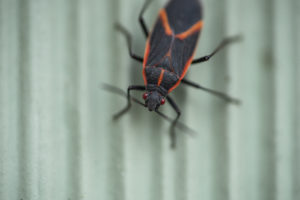The Yellow Sac Spider is also known as the Black-Footed Spider because their black feet make it easy to spot them on your walls and ceilings. They are very common in the United States and are slightly more aggressive than most other house spiders. The yellow sac spider is the cause of many spider bites and other issues such as weaving webs that block airflow fuel tank hoses in Mazda’s! It’s an albino-looking spider that ranges from light yellow to pale yellowish-green in color and can also have an orange-brown stripe on its abdomen. The head and thorax are orange-brown to reddish and the abdomen is pale yellow. The color of their body can change in hue depending on the insect they have most recently consumed. The size, including its leg span, can be up to an inch for females. The males are more slender with a slightly larger leg span. The first pair of legs are longer than the fourth pair and they have eight eyes that are all about the same size in two horizontal rows.
Yellow Sac Spider Preferred Habitat Locations
Yellow sac spiders do not build webs. They live in flattened silk tubes during the day and will emerge at night to hunt. The silken tubes they create can be found within leaves, under landscape logs or timbers and where walls meet the ceiling. They will hunt spiders larger than themselves and even their own eggs and will search foliage like leaves and stems of plants, grass, shrubs, and other vegetation. They will make their way into homes, more so in the fall when their food supply starts to drop off. They will also come inside during the winter months to escape the cold and frost. You can often find them in your home crawling on the walls or other vertical surfaces.
Are Yellow Sac Spiders Venomous or Poisonous?
The terms venomous and poisonous are often used interchangeably by many people but they do not mean the same thing! The difference between them is in how the toxin is delivered. Venomous organisms such as spiders and bees inject their venom using their fangs or a stinger for example. Poisonous organisms like some caterpillars and butterflies deliver their toxins when they are simply touched or eaten. Yellow sac spiders and obviously venomous as opposed to poisonous.
What Does a Yellow Sac Spider Bite Look Like?
No consensus has been made on how toxic the bite or a yellow sac spider is, but it’s not known to be deadly. If the yellow sac spider is disturbed or threatened it has no problem biting you, whether it’s on purpose or accidentally, with fangs that can penetrate human skin quite easily. We are likely to get bitten when we’re gardening or taking care of outdoor activities. The venom contains a mild and local cytotoxic that can affect cells and a neurotoxin that is poisonous to nerve tissue. Many times, a suspected brown recluse spider bite may actually be from a yellow sac spider. You may develop a small red bump that will fade away after a couple of weeks while others may have swelling, burning, and pain with a pustule developing that will heal on its own over the same time frame. If you happen to get bitten, you should try to catch the spider for identification.
Yellow Sac Spider Infestation Prevention & Control
Sealing holes, cracks and gaps around windows, doors and the foundation where they can enter will do a lot in the way of prevention. You can also remove clutter inside and out (that yellow sac spiders like to live in) and remove any egg sacs with a vacuum cleaner. Contact a pest control specialist, like Rentokil for any assistance in controlling yellow sac spiders or other pests. We will perform an inspection and come up with a management plan to effectively deal with them.

 Boxelder bugs are insects that are black with orange or red lines on the thorax and sides. They have flat wings and are ½ an inch long as adults. Outdoors, they make their homes in boxelder, maple, and ash trees. They aren’t pests in the summer as they go unnoticed, but are a problem in the fall as they search for a place to spend the winter. They are generally inactive in the winter but if the day is sunny and warm, they can become mobile in the walls and attic. An infestation may not occur all at once at the same time, as they will be in different parts of the home and the warmth will not reach them all equally. Any boxelder bug you see inside your home in the winter and spring made its way inside the previous fall.
Boxelder bugs are insects that are black with orange or red lines on the thorax and sides. They have flat wings and are ½ an inch long as adults. Outdoors, they make their homes in boxelder, maple, and ash trees. They aren’t pests in the summer as they go unnoticed, but are a problem in the fall as they search for a place to spend the winter. They are generally inactive in the winter but if the day is sunny and warm, they can become mobile in the walls and attic. An infestation may not occur all at once at the same time, as they will be in different parts of the home and the warmth will not reach them all equally. Any boxelder bug you see inside your home in the winter and spring made its way inside the previous fall.